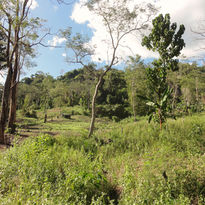
Community Tamaraw Driven Landscape Program
Conservation and Enhancement of the Natural and Cultural Heritage of Mindoro
The Community – Tamaraw Driven Landscape Program was initiated by its current Program Manager, Emmanuel Schütz in 2012, and thereafter embraced by the D’ABOVILLE Foundation and Demo Farm Inc and its President Mr. Hubert d’Aboville, as one of its main commitment and project. The Program is built through and in collaboration with local and international partners spurred on by the IUCN-SSC Asian Wild Cattle Specialist Group (AWCSG).
WHY PHILIPPINES?
The Philippine archipelago is one of the mega-diverse regions of the planet in terms of biodiversity. Hence the challenges are huge to combine preservation of this amazing natural richness and the aspiration of an ever growing and demanding human population.
WHY MINDORO?
Mindoro was colonized by Filipino settlers coming from other provinces only recently, and continues today nursing a spirit of last frontier. The Island still harbors tracks of under-surveyed mountainous regions in challenging landscape with yet poorly studied biodiversity. Most particularly it is home of the Mangyan indigenous tribes who, despite the relative small size of the island, manage to defend and preserve their cultural identity; Mangyan communities residing nearby lowlander Filipino settlers playing the role of buffer to guard their fellows in the upland from disruptive intrusion, thus claiming rights to remain secluded and pursue traditional lifestyle. Nevertheless, a century of environmental degradation and unflagging modernization movement is taking its toll and pushes everyone to position itself towards choices in terms of tradition and development.
Therefore, Mindoro provides fertile ground for inspirational approach to consider land-use systems and conceive biodiversity conservation projects; in other words an invitation for a shift of paradigm in what we trivially call sustainable development.
WHY TAMARAW?
The Tamaraw (Bubalus mindorensis) or Mindoro dwarf buffalo is endemic to the island of Mindoro and the only wild cattle species of the Philippines. It is therefore one of the many singular outcome of the natural evolution and an emblematic species that the country can claim as its national treasure. It is currently considered as Critically Endangered (CR) on the Red List of the IUCN.
Its conservation and iconic status exhorts stakeholders to position the space they claim to afford for wildlife, in a country where all terrestrial Protected Areas and more generally all natural landscapes have people living in it. Nowadays all remaining tamaraw populations are located within the Ancestral Domain of the Mangyans, making tamaraw conservation a social perspective and not a pure technical protection issue.
Somehow, the Tamaraw provides the opportunity to think of conservation in the frame of a bio-cultural landscape through a holistic approach where successful wildlife conservation shall be the consequence of a preserved or restored wealthy socio-cultural environment.
OUR VISION AND STRATEGY OF INTERVENTION
Goal and vision of the Community– Tamaraw Driven Landscape Program
.png)
.png)
Response and strategy of intervention


Our Partners

Our Sponsors

OBJECTIVES
In 2020, the Philippines authorities have endorsed the Tamaraw Conservation and Management Action Plan which paves the way for long term coordinated conservation efforts through an initial 10 years work plan and guideline. The Protected Area General Management Plan for Mts Iglit-Baco Natural Park is being adopted. It will provide a framework of action for this protected area decades after its creation. This is the outcome of 6 years of strong commitment of DAF in the field beside its local partners and support of international partners.
Today, the Program is structured towards supporting the local stakeholder to properly implement those plans and all initiative in all tamaraw sites.
Fields of actions are currently concentrating on three aspects with a focus on MIBNP:
-
Improve law enforcement and wildlife crime prevention by the concerned offices and increase patrolling efficiency of the rangers.
-
Engage more seriously with the indigenous communities concerned by tamaraw presence through community based approach in order to assist them in dealing with numerous complex government regulations and to guide them in adapting to a fast changing world that is pushing them to restructure their overall living space and social organization.
-
Conduct ecological work on the biology of the Tamaraw and other wildlife and the habitats they can be found and develop consistent monitoring methods, thus assisting the authorities to adapt and implement relevant habitat management measures.


























